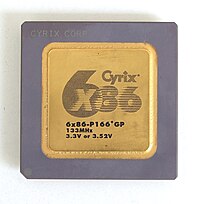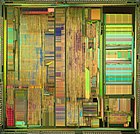Cyrix 6x86
| Cyrix 6x86MX | |
|---|---|
 6Cyrix 6x86-P166 + GP |
|
| Production: | February 1996 to 1997 |
| Producer: | Cyrix , IBM and ST Microelectronics |
| Processor clock: | 80 MHz to 150 MHz |
| FSB cycle: | 40 MHz to 75 MHz |
| L1 cache size: | 16 KiB |
| Instruction set : | x86 |
| Base: | Base 5 , base 7 |
| Name of the processor core: | M1 |
The Cyrix 6x86 is a 5th generation microprocessor ( 80586 series), which was developed by the Cyrix company .
Technical
The Cyrix 6x86 (codenamed M1) is a superscalar , super pipelined x86 CPU, the pin-compatible with the Intel Pentium and thus in the common for marketing period base 5 - motherboards could be used. The 6x86 was available as P90 +, P100 + (90 MHz), P120 + (100 MHz), P133 + (110 MHz), P150 + (120 MHz), P166 + (133 MHz) and P200 + (150 MHz). As with earlier CPUs from Cyrix, the 6x86 was also sold under their names by the manufacturing partners IBM and STMicroelectronics .
The 6x86 has many of the features and design characteristics of the Pentium Pro ; its integer performance is superior to that of an equally clocked Intel Pentium. A 6x86 with 133 MHz is faster in the integer range than an Intel Pentium 166. This is why the so-called P-Rating (PR) was used to specify the speed of the CPU. The FPU performance is, however, inferior to that of the Intel Pentium, which, however, was less relevant for many of the applications common at the time. The superiority of the integer performance and a significantly lower selling price than Intel's Pentium series brought Cyrix a considerable market share with the 6x86 . Cyrix had the second highest market share in the x86 area, well ahead of AMD .
However, the 6x86 is not always unproblematic: In addition to the FPU weakness, inflexible multipliers that are limited to x2 and x3 cause problems. Sometimes an FSB clock rate must be used that violates the specifications of the PCI bus. This leads to problems with many PCI cards. In addition, the CPUs generate a lot of waste heat compared to other processors common at the time . Cyrix was able to alleviate this problem somewhat with the later introduced DualVoltage 6x86L.
Model data
- Code name: M1, M1L
- Sold as: Cyrix 6x86 (L), IBM 6x86 (L), ST 6x86 (L)
- L1 cache: 16 KiB (unified)
- L2 cache: depending on the motherboard or chipset used
- Socket 5 / Socket 7 with a front side bus from 40 to 75 MHz
- Operating voltage (VCore): 3.45 V or 3.3 V (6x86L: 2.8 V)
- Release DATE: February 1996
- Manufacturing technology : 0.65 µm (later 0.35 µm) at IBM and ST Microelectronics
- The size: 394 or 225 mm² (169 mm² at 0.35 µm) with 3.0 million transistors
- Clock rates: 80 MHz to 150 MHz
- P90 + : 80 MHz (less often than 6x86-80GP)
- P100 +: 90 MHz
- P120 +: 100 MHz (also as 6x86-100GP)
- P133 +: 110 MHz
- P150 +: 120 MHz
- P166 +: 133 MHz
- P200 +: 150 MHz



